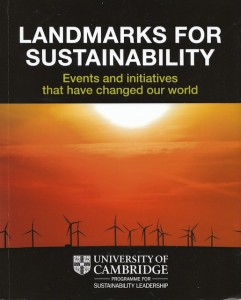Our Geophysical Experiment
Chapter by Wayne Visser
Extract from Landmarks for Sustainability
Quotes
I worry about climate change. It’s the only thing that I believe has the power to fundamentally end the march of civilization as we know it, and make a lot of the other efforts that we’re making irrelevant and impossible – Bill Clinton, former US President
Climate change is the most severe problem that we are facing today, more serious even than the threat of terrorism” – Sir David King, former UK government chief scientific adviser
Climate change: It’s here. If we don’t react, war, pestilence and famine will follow close behind – R K Pachauri, Chairman, Intergovernmental Panel on Climate Change (IPCC)
If we follow business as usual I can’t see how west Antarctica could survive a century. We are talking about a sea-level rise of at least a couple of metres this century … What we have found is that the target we have all been aiming for is a disaster – a guaranteed disaster – James Hansen, US climate scientist and head of Head of NASA Goddard Institute for Space Studies
Our “large-scale geophysical experiment” …
 Scientists have long been aware of the earth’s extreme temperature variations, with the last major ice age ending about 10,000 years ago. However, in 1824 Jean-Baptiste Fourier discovered a global warming (or greenhouse) effect, and in 1861, the Irish physicist John Tyndall carried out key research on carbon dioxide (CO2) and heat absorption.
Scientists have long been aware of the earth’s extreme temperature variations, with the last major ice age ending about 10,000 years ago. However, in 1824 Jean-Baptiste Fourier discovered a global warming (or greenhouse) effect, and in 1861, the Irish physicist John Tyndall carried out key research on carbon dioxide (CO2) and heat absorption.
In 1896, Swedish and American scientists independently concluded that CO2 was the likely cause of global warming. By 1957, US oceanographer Roger Revelle was warning that humanity is conducting a “large-scale geophysical experiment”, while colleague David Keeling set up the first continuous monitoring of CO2 in the atmosphere, confirming year-on-year-rises.
Despite these early signs, it took until 1979 for the first World Climate Conference, organised by the World Meteorological Organisation (WMO), to state that “continued expansion of man’s activities on earth may cause significant extended regional and even global changes of climate”. This led WMO and the United Nations Environment Programme (UNEP) to establish a scientific advisory body – the Intergovernmental Panel on Climate Change (IPCC).
The IPCC issued its First Assessment Report in 1990, finding that the planet had warmed by 0.5°C in the past century and would rise further by 0.3°C per decade in the 21st century, accompanied by global mean sea level rises of 6 cm per decade. Convinced that the world needed a global policy response, the UN established the Framework Convention on Climate Change (UNFCCC), which 154 nations (including the US) signed at the Rio “Earth Summit” in 1992.
In 1995, the IPCC Second Assessment Report confirmed that concentrations of greenhouse gas reductions (GHGs) were continuing to increase, and that the socio-economic impacts of climate change were significant, while the UNFCCC began negotiations on an international agreement to limit the emission of GHGs. The result was the Kyoto Protocol, adopted in 1997, which: 1) set mandatory targets for emission reductions for the world’s 38 leading economies, and 2) proposed three flexible market mechanisms for achieving these reductions through carbon trading. The targets collectively amounted to a 5.2% global reduction in GHGs from these countries against 1990 levels by 2012.
Despite US opposition to the Protocol, momentum continued to build, with the EU launching its Emissions Trading Scheme for CO2 in 2005. In 2007, the UK’s Stern Review, prepared by former World Bank Chief Economist Sir Nicholas Stern, warned that tackling climate change will cost around 1% of global GDP, whereas the cost of not acting could be between 5% and 20%. Shortly thereafter, the IPCC released its 4th Assessment Report, concluding with 90% confidence that human activity is causing climate change. It seemed the tide was turning, in no small part thanks to former US Vice-President Al Gore, who received an Oscar for his movie, An Inconvenient Truth, and a Nobel Prize, shared with IPCC. This seemed to mark the end of denial and the beginning of urgent global action on climate change …
Continue reading
[button size=”small” color=”blue” style=”download” new_window=”false” link=”http://www.waynevisser.com/wp-content/uploads/2012/04/book_landmarks_chap3_climate.pdf”]Pdf[/button] Our Geophysical Experiment (chapter)
Related pages
[button size=”small” color=”blue” style=”info” new_window=”false” link=”http://www.waynevisser.com/books/landmarks-for-sustainability”]Page[/button] Landmarks for Sustainability (book)
Cite this chapter
Visser, W. (2009) Climate Change, In W. Visser & Cambridge Programme for Sustainability Leadership, Landmarks for Sustainability: Events and Initiatives That Have Changed the World, Sheffield: Greenleaf.


